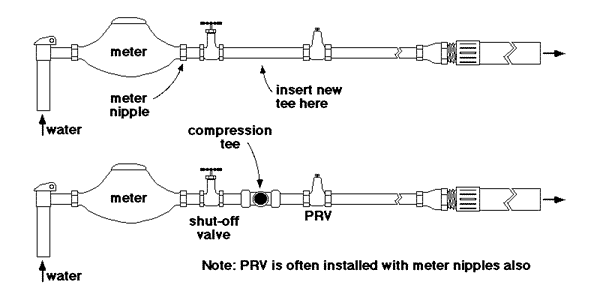We have an extensive list of FAQs (Frequently Asked Questions). If you have questions you don't see answered below, look for the answer in our FAQ section.
male
As for the instructions for installing threaded and glued connections, these instructions presume that this work is being done in a mild climate where water meters are normally installed in the yard by the street- where the hookup is performed by digging and installing fittings in direct contact with the soil. In colder climates, the meter may be located in the basement, eliminating the need to dig in order to access the meter connections. It should be clear how to modify these directions to accomplish a connection in a colder climate- just ignore all the digging! As you read the instructions on this page, refer to the picture below.

Dig up the water line
Dig up the water line from the outlet of the meter all the way to a foot or two past the shut-off valve. Dig a few inches under the line to allow a place for water to drain without putting the line in a mud puddle, and to allow for some movement of the line in all directions. Be careful, of course, not to damage the line while exposing it. As you are digging, decide where you want to place the backflow preventer and dig out an area long, wide and deep enough to accomodate the backflow preventer and it's box. Normally, the backflow preventer must be located on your property, not in the setback which may extend several feet into "your" lawn. The edge of your property is often marked by the first expansion joint in the driveway.
Shut off the water supply
First, shut off the water to the meter using the angle valve on the street side of the meter.
Installing the new tee
Cut through the pipe after the shut-off valve and remove a short section of the pipe, an inch or so is usually enough. Debur and clean the ends of the pipe and slip the tee onto one of the cut ends. Lower the pipe until it is even with the other piece, and slide the compression fitting back until it is centered over the cut You can look through the side connection on the tee to make sure it's centered correctly. Swivel the tee until it points in the right direction, and tighten the compression nuts on the ends of the tee. We recommend using metal compression tees rather than plastic tees, as we believe they are more reliable.
A note about water pressure
Note: If you have unusually high pressure you may have a PRV installed after the shut-off valve. You can install the sprinkler system downstream of the PRV if you want to take advantage of the regulated pressure, but this will probably result in noticeable drop in water pressure while watering. This may not be a problem if all watering is done at night while everyone is asleep. If you install the system between the shut-off valve and the PRV, you won't see much (if any) effect on house water pressure during watering, but you will definitely need to to provide for pressure or flow control (for instance by installing a master valve with flow control). If you have no PRV, then you probably have moderate to low pressure and flow controls may not be critical, although they are important to obtain good pressure balance as explained in the section on adjusting your sprinkler system.
Connecting your backflow preventer
Tape a male adapter with Teflon tape and screw it into the new tee. By using two tees as described in the Tips and Tricks section on "funny angles", you can arrange for a pipe to head toward your sprinkler shut-off valve and backflow preventer at just about any angle. A couple more tees may be required at the sprinkler shut-off valve and backflow preventer to establish the right height and angle for those devices as well. Remember to observe the code requirements for depth of cover for the pipe between the supply line and the backflow preventer.
Mounting your backflow preventer
Be sure to check on clerances for mounting the backflow preventer. If it is above ground there will be minimum clearances above grade or the highest sprinkler. If it is below ground (a DCA) there may be restrictions on the distance from the DCA to the bottom of the box enclosure, to the top, as well as for the orientation of the test and repair ports (up). If there are restrictions, your building permit office or water utility should be able to explain them to you.
Install the master valve
If you chose to install a master valve (a good move) it goes after the backflow preventer and should be located close to the backflow preventer. After the master valve is installed, it's time to start laying the main line, station valves, lateral lines and sprinklers.
How to make a threaded and glued connection
Back to main backflow instruction page
Back to main installation instruction page
| If you've benefited from the help we've provided on our site but you choose not to purchase your parts from us, we hope you will consider making a small donation to help offset the cost of maintaining this site. To make a donation, you can click on a button below and follow the on-screen instructions. |
|
|
|
|
Thanks!
The staff at WaterTips.com |
|




